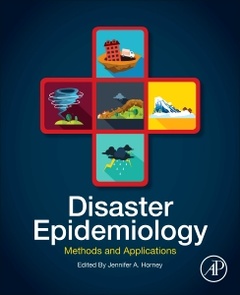Disaster Epidemiology Methods and Applications
Coordonnateur : Horney Jennifer

Disaster Epidemiology: Methods and Applications applies the core methods of epidemiological research and practice to the assessment of the short- and long-term health effects of disasters. The persistent movement of people and economic development to regions vulnerable to natural disasters, as well as new vulnerabilities related to environmental, technological, and terrorism incidents, means that in spite of large global efforts to reduce the impacts and costs of disasters, average annual expenditures to fund rebuilding from catastrophic losses is rising faster than either population or the gross world product. Improving the resilience of individuals and communities to these natural and technological disasters, climate change, and other natural and manmade stressors is one of the grand challenges of the 21st century. This book provides a guide to disaster epidemiology methods, supported with applications from practice. It helps researchers, public health practitioners, and governmental policy makers to better quantify the impacts of disaster on the health of individuals and communities to enhance resilience to future disasters.
Disaster Epidemiology: Methods and Applications explains how public health surveillance, rapid assessments, and other epidemiologic studies can be conducted in the post-disaster setting to prevent injury, illness, or death; provide accurate and timely information for decisions makers; and improve prevention and mitigation strategies for future disasters. These methods can also be applied to the study of other types of public health emergencies, such as infectious outbreaks, emerging and re-emerging diseases, and refugee health. This book gives both the public health practitioner and researcher the tools they need to conduct epidemiological studies in a disaster setting and can be used as a reference or as part of a course.
An Introduction to Disaster Epidemiology Josephine Malilay and Jennifer A. Horney 1. History of Disaster Epidemiology: 1960-2015 Jennifer A. Horney 2. Methods: Surveillance Kahler Stone Vignettes: Veterans Health Affairs, Veterans, and Disasters Tiffany Radcliff, Aram Dobalian and Karen Chu 3. Applications: Informatics: Using Information Systems to Improve Surveillance During Disasters Laura Edison, Karl Soetebier and Hope Dishman 4. Applications: Shelter Surveillance Rebecca Jean Heick Post-Disaster Carbon Monoxide Surveillance Kanta Sircar and Dorothty Stearns 5. Applications: Mortality Surveillance Rebecca S. Noe 6. Study Designs in Disaster Epidemiology Latasha Allen and Jennifer A. Horney 7. Applications: CASPER Amy Helene Schnall, Amy Wolkin and Tesfaye Mekonnen Bayleyegn Applications: ACE Maureen F. Orr and Mary Anne Duncan Vignettes from Recent Responses: California Geothermal Gas Vents Svetlana Smorodinsky, Tracy Barreau and Jason Wilken Vignettes from Recent Responses: California Drought Jason Wilken, Svetlana Smorodinsky and Tracy Barreau 8. Methods: Questionnaire Development and Interviewing Techniques Amy Helene Schnall, Amy Wolkin and Nicole Nakata Vignettes from Recent Responses: Foodborne Marilyn Felkner, Venessa Cantu and Kevin Mcclaran 9. Applications: Social Vulnerablity to Disaster (Hampton and Hertford Counties - Isabel) Danielle Spurlock 10. Applications: Responder Safety Renee Funk Vignettes from Recent Responses: Pregnant Women and Ebola Jonetta Johnson Mpofu and Michelle Dynes 11. Methods: Data Analysis Ashley Conley 12. Applications: Bioterrorism, Biodefense, and Biotechnology Koya Allen Vignettes: Natural Disasters and Climate Change Joel Casey Dietrich Vignettes: Impacts on People with Pre-existing Chronic Medical Conditions Pamela Allweiss 13. Applications: Disaster Communication and Community Engagement Jennifer C. Beggs Vignette from Recent Responses: Roseburg Oregon Mass Shooting Akiko M. Saito 14. Discussion and Conclusion - What Disaster Epidemiology Can Contribute to Resilient Communities Jennifer A. Horney Appendix: Resources from Disaster Libraries Suzanne Shurtz Clark
Students and researchers at Schools of Public Health; local, regional, state, and federal public health practitioners (epidemiology, laboratory, public health preparedness) and those working in global health and international disaster response (e.g. agencies such as CARE, Child Health, CRDF Global).
- Provides a holistic perspective to epidemiology with an integration of academic and practical approaches
- Showcases the use of hands-on techniques and principles to solve real-world problems
- Includes contributions from both established and emerging scholars in the field of disaster epidemiology
Date de parution : 10-2017
Ouvrage de 212 p.
19x23.3 cm



